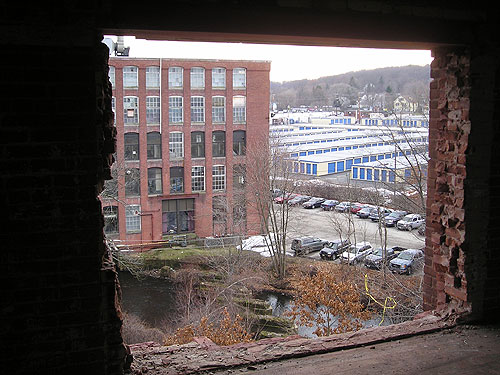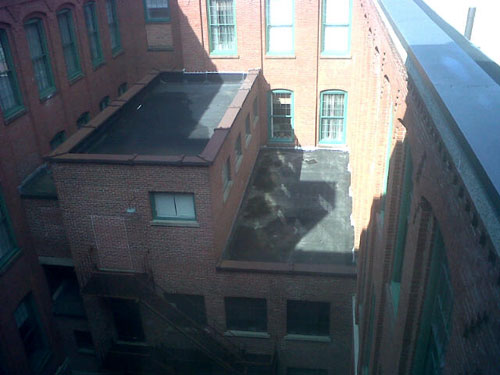Article and photos by David DeStefano
Each year, numerous firefighters are killed or injured when they fall from roofs, windows, stairways, shafts, or other openings. Performing accurate size-up, maintaining situational awareness, and reinforcing basic skills will make these events less likely.
Size-up always includes aspects operational safety. Among these concerns should be the possibility of uncommon building features that increase the likelihood that a firefighter may suffer a fall. These uncommon features may be the product of design, renovation, occupancy, or fire conditions. Knowledge of the response area and preincident familiarization with typical layouts will help members recognize buildings with interior light shafts, open conveyors between floors, mezzanines, or other features that may create fall hazards during firefighting operations.
Some common hazards found in many occupancies may include:
- Open stairwells/convenience stairs
- Interior shafts for conveyors/open hoistways
- Light shafts
- Mezzanine levels
- Flat roofs without parapets
- Demolition or construction openings
- Partial floor collapse
- Hoarding conditions
Firefighters may encounter convenience stairs in office suites that span two floors of a building. To facilitate employee access to the offices without having to go through a common corridor or elevator, a set of stairs may be found that connect only the two floors occupied by a particular tenant. In manufacturing facilities, open hoistways for freight elevators or conveyor systems may endanger firefighters working in a smoke-filled environment.
Many industrial occupancies with large, open areas feature offices or storage areas that create a mezzanine level within the building. Firefighters may find and access these areas for search without realizing they are above the main floor space of the building often with little to prevent them from going over the edge of the mezzanine. Many places of assembly also feature a mezzanine level for the dramatic view it creates over a main lobby or ballroom. These spaces may be perfectly safe under normal conditions, but an unwitting firefighter may go over the edge in a smoke-filled environment.
It’s said that the most dangerous time to conduct firefighting operations is when a building is under construction, renovation, or demolition. Temporary walls and floor and roof system openings may be protected by flimsy barriers that will not withstand the weight of a firefighter.
Performing vertical ventilation on a flat roof is a dangerous operation not only because of firefighters’ proximity to the path of fire spread but roof features that serve to endanger the safety of the roof team. Numerous firefighters have simply walked off flat roofs without a parapet. Other occupancies may feature a parapet on only a portion of the structure, giving firefighters a false sense of security in smoke or darkness. Light shafts or interior courtyards are prevalent in particular structures. Many older factory or residential buildings feature a center courtyard that creates additional windows for interior portions of the building. This feature was especially useful before the advent of efficient electrical lighting. In modern buildings, it may create a “green space” in the interior of the building’s footprint. In either scenario, such spaces may create a hazard for members working on the roof.
Hoarding conditions within residential occupancies put firefighters at risk by traversing piles of contents. Floors may be seriously overloaded and piles of contents unsteady. In addition, members working on top of these piles may be at the same height as a window, sill making it easy to fall from an upper floor.
Inexperienced or complacent firefighters operating on the modern fireground with the excellent protection provided by personal protective equipment and self-contained breathing apparatus often have a tendency to walk upright simply because their thermal and respiratory protection allows them to do so. The simple solution to walking on the fireground is that if you can’t see your feet, you should be crawling. Whether you are operating inside the building or on the roof, no matter if the smoke is hot or cold, the likelihood of falling is greatly reduced if you are crawling.
In addition to crawling, firefighters should maintain the habit of running a tool out in front of them as they advance. A hook or halligan tool in front of the crawling firefighter will allow added time to react to a sudden drop-off. Simple preparation like carrying multiple sources of light may improve visibility just enough to recognize an upcoming hazard. Using a helmet-mounted light, a chest-mounted light on a turnout coat, and a large sturdy handlight with a shoulder strap together will help provide light at different angles for a better perspective. In addition, the redundancy of multiple lights improves the safety and efficiency of operations.
Firefighters who are knowledgeable about their response area, move with deliberate caution in smoke, and remember that if they can’t see their feet it isn’t safe to walk will be less likely to become victims of falls during firefighting operations. When making an aggressive attack, members must know that they need to crawl before they can walk.

(1) Operating in buildings under renovation or demolition may present significant fall hazards to firefighters.

(2) Members ascending to the roof on a portion of the building with a parapet may gain a false sense of security as this occupancy features a partial parapet.

(3) Firefighters operating on the main roof of this building face the danger of falling into the interior courtyard when visibility is obscured.
 David DeStefano is a 23-year veteran of the North Providence (RI) Fire Department, where he serves as a lieutenant in Ladder Co. 1. He previously served as a lieutenant in Engine 3 and was a firefighter in Ladder 1. He teaches a variety of topics for the Rhode Island Fire Academy. He can be reached at dmd2334@cox.net.
David DeStefano is a 23-year veteran of the North Providence (RI) Fire Department, where he serves as a lieutenant in Ladder Co. 1. He previously served as a lieutenant in Engine 3 and was a firefighter in Ladder 1. He teaches a variety of topics for the Rhode Island Fire Academy. He can be reached at dmd2334@cox.net.
MORE ON THE LINE

